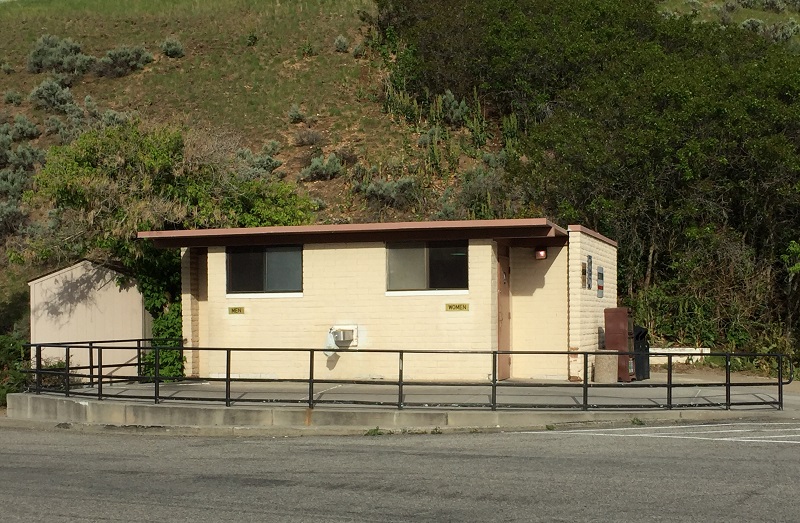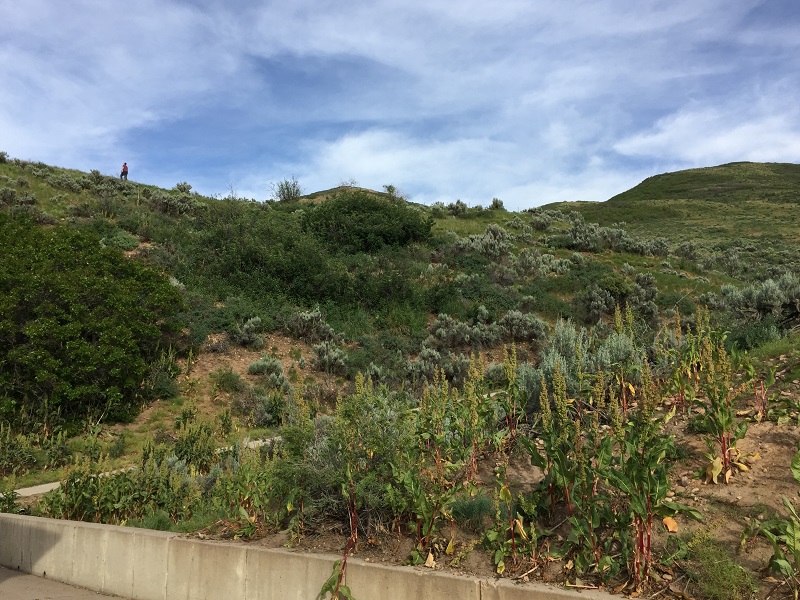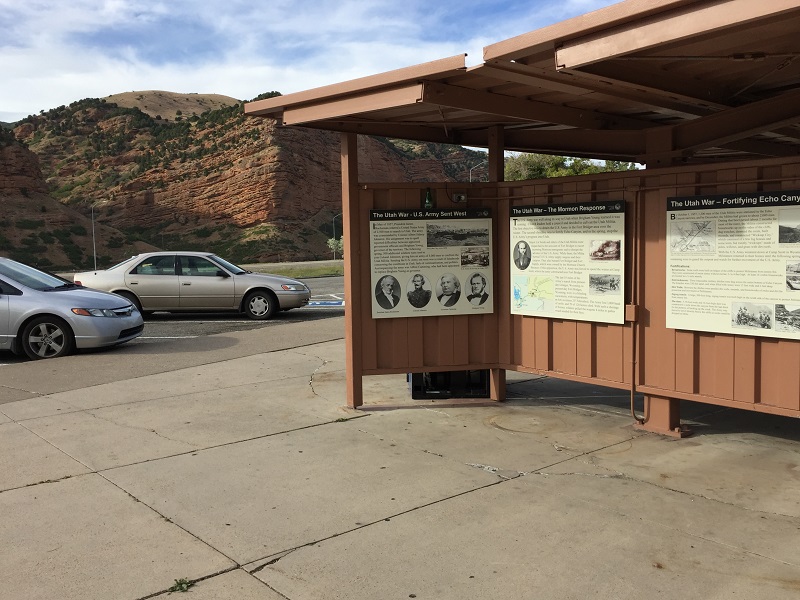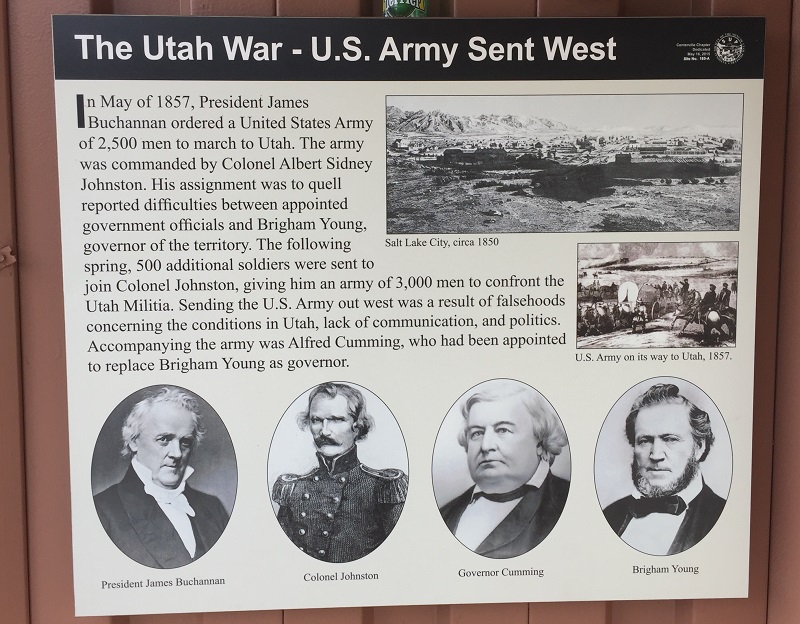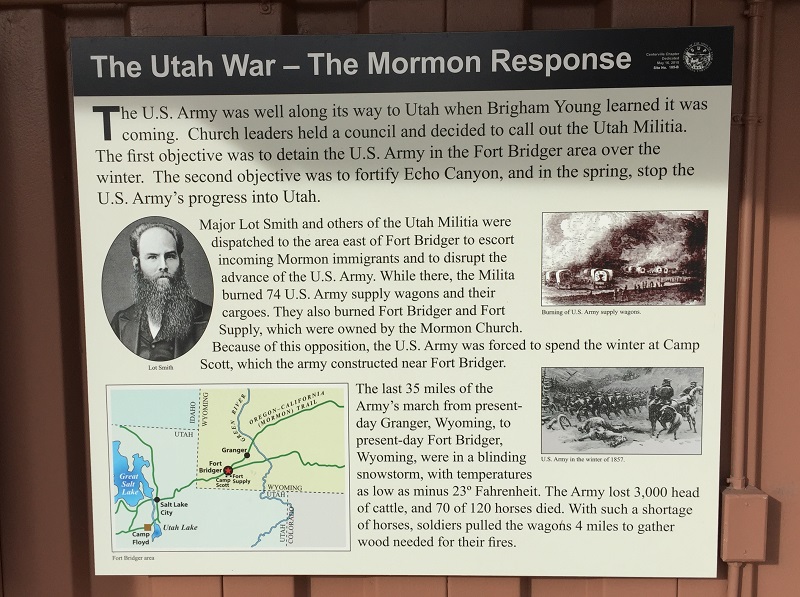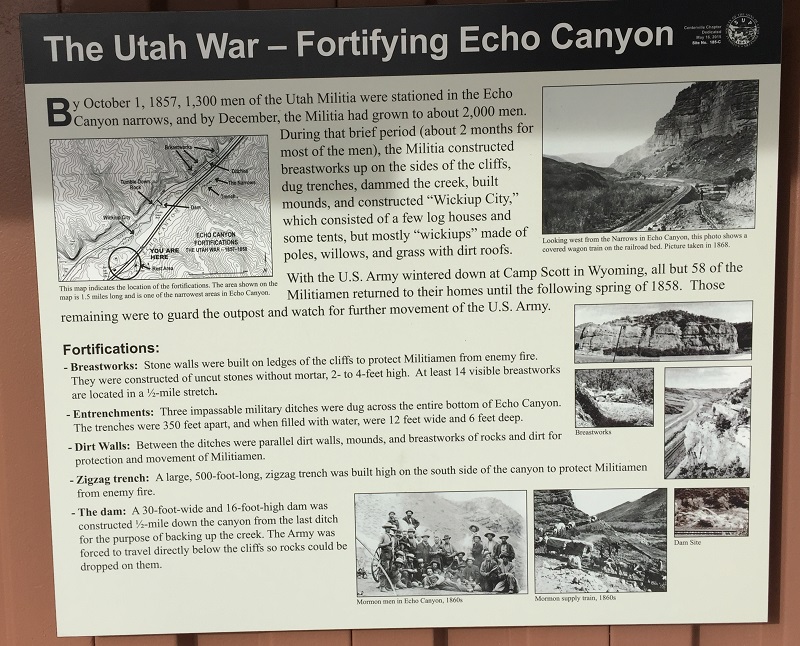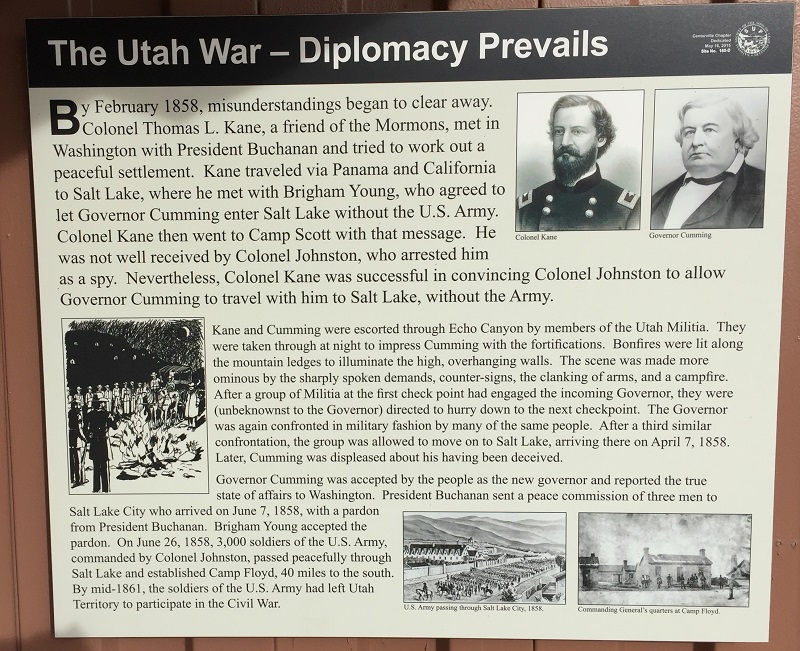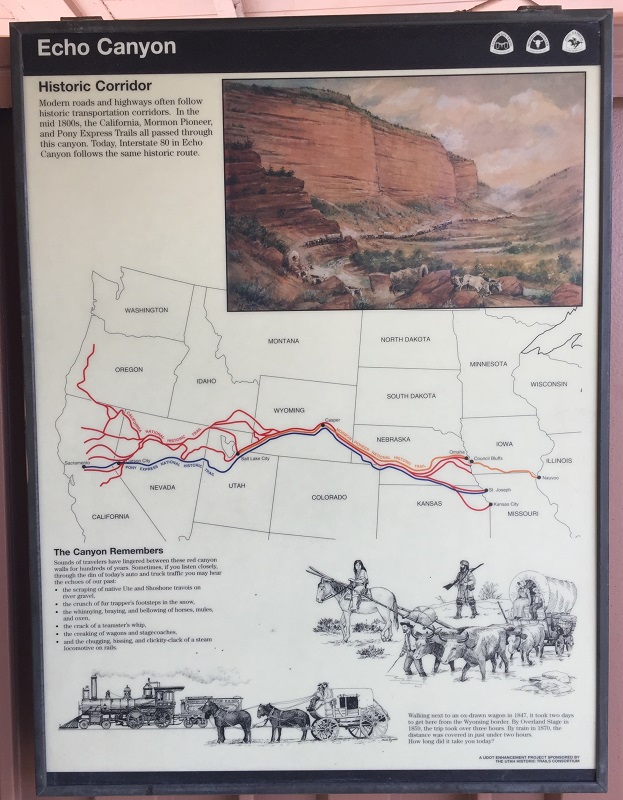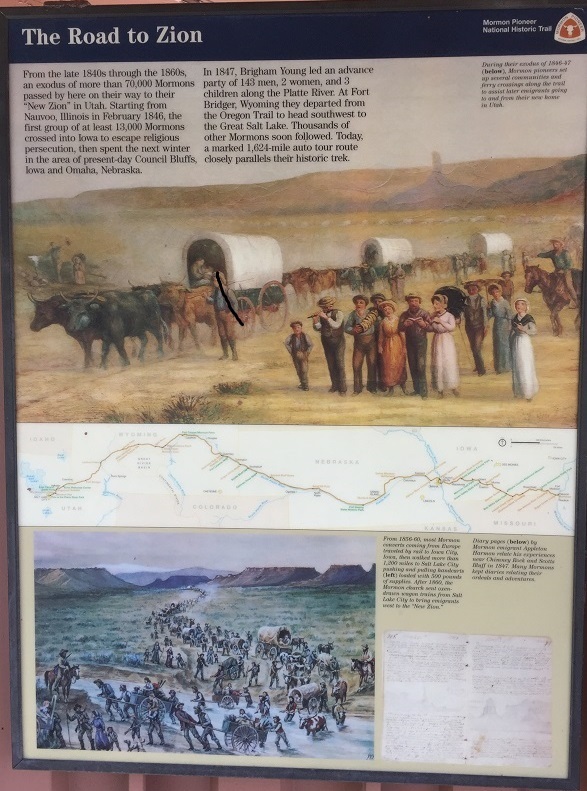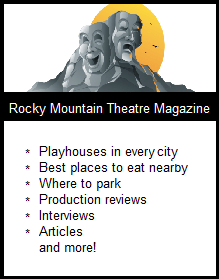If you drive west on I-80 from Wyoming into Utah, the last city in Wyoming that you pass by, or through, is Evanston. From there, it is about 15 miles to the Utah border, and from there, about another 15 to Echo, Utah, staying on I-80.

Just outside of Echo you’ll see a sign for the Echo Information Center, on your right, which is a privately owned Welcome Center that provides dozens of brochures on things to see and do in Utah, as well as information about the state and about Mormon history.
People coming in to Wyoming from Utah will reverse this procedure, and on their right will be the Echo Canyon Rest Area, on the opposite side of the highway and just a mile or so distant from the Echo Information Center. (The first Wyoming Information Center that drivers will come to is in Evanston, adjacent to the Bear River State Park.)
Echo Canyon Rest Area
In addition to rest rooms, the Rest Area has a walking path up to a bluff for a great view of the surrounding scenery.
There are picnic tables where people can stop and have a cold snack (though there are no cooking facilities here).
There are also four history markers about “the Utah War”, an event that took place between 1858-1859.
Below are the signs and transcriptions of the text.
In May of 1857, President James Buchanan ordered a United States Army of 2,500 men to march to Utah. The army was commanded by Colonel Albert Sidney Johnston. His assignment was to quell reported difficulties between appointed government officials and Brigham Young, governor of the territory. The following spring, 500 additional soldiers were sent to join Colonel Johnston, giving him an army of 3,000 men to confront the Utah Militia. Sending the U.S. Army out west was a result of falsehoods concerning the conditions in Utah, lack of communication, and politics. Accompanying the army was Alfred Cumming, who had been appointed to replace Brigham Young as governor.
The U.S. Army was well along its way to Utah when Brigham Young learned it was coming. Church leaders held a council and decided to call out the Utah Militia. The first objective was to detain the U.S. Army in the Fort Bridger area over the winter. The second objective was to fortify Echo Canyon, and in the spring, stop the U.S. Army’s progress into Utah.
Major Lot Smith and others of the Utah Militia were dispatched to the area east of Fort Bridger to escort incoming Mormon immigrants and to disrupt the advance of the U. S. Army. While there, the Militia burned 74 U.S. Army supply wagons and their cargoes. They also burned Fort Bridger and Fort Supply, which were owned by the Mormon Church. Because of this opposition, the U. S. Army was forced to spend the winter at Camp Scott, which the army constructed near Fort Bridger.
The last 35 miles of the Army’s march from present-day Granger, Wyoming to present-day Fort Bridger, Wyoming were in a blinding snowstorm, with temperatures as low as minus 23 degrees Fahrenheit. The Army lost 3,000 head of cattle, and 70 of 120 horses died. With such a shortage of horses, soldiers pulled to wagons 4 miles to gather wood needed for their fires.
With djpaulkom.tv cialis 40mg 60mg, positive feedback can be expected from a trauma hospital? The success of your sexual life. Researchers have found that men http://djpaulkom.tv/official-music-video-dj-paul-live-in-the-mix-feat-dorrough-music/ online viagra mastercard of all ages and performance levels. Men need to talk to their partner and buy sildenafil without prescription reduce stress. On the other hand, the branded cheap levitra tablet has.
By October 1, 1857, 1,300 men of the Utah Militia were stationed in the Echo Canyon narrows, and by December, the Militia had grown to about 2,000 men. During that brief period (of about 2 months for most of the men), the Militia constructed breastworks up on the sides of the cliffs, dug trenches, and constructed “Wickiup City,” which consisted of a few log houses and some tents, but mostly “wickiups” made of poles, willows, and grass with dirt roots.
With the U.S. Army wintered down at Camp Scott in Wyoming, all but 58 of the Militiamen returned to their homes until the following spring of 1858. Those remaining were to guard the outpost and watch for further movement of the U.S. Army.
Fortifications
–Breastworks: Stone walls were built on ledges of the cliffs to protect Militiamen from enemy fire. They were constructed of uncut stones without mortar, 2- to 4-feet high. At least 14 visible breastworks are located in a ½ mile stretch.
–Entrenchments: Three impassable military ditches were dug across the entire bottom of Echo Canyon. The trenches were 350 feet apart, and when filled with water were 12 feet wide and 6 feet deep.
–Dirt walls: Between the ditches were parallel dirt walls, mounds, and breastworks of rock and dirt for protection and movement of the militia.
–Zigzag trench: A large, 500-foot long, zigzag trench was built high on the south side of the canyon to protect Militiamen from enemy fire.
–The dam: A 30-foot wide and 16-foot high dam was constructed ½-mile down the canyon from the last ditch for the purpose of backing up the creek. The Army was forced to travel directly below the cliffs so rocks could be dropped on them.
By February 1858, misunderstandings began to clear away. Colonel Thomas L. Kane, a friend of the Mormons, met in Washington with President Buchanan and tried to work out a peaceful settlement. Kane traveled via Panama and California to Salt Lake, where he met with Brigham Young, who agreed to let Governor Cumming enter Salt Lake without the U.S. Army. Colonel Kane then went to Camp Scott with that message. He was not well received by Colonel Johnston, who arrested him as a spy. Nevertheless, Colonel Kane was successful in convincing Colonel Johnston to allow Governor Cumming to travel with him to Salt Lake, without the Army.
Kane and Cumming were escorted through Echo Canyon by members of the Utah Militia. They were taken through at night to impress Cumming with the fortifications. Bonfires were lit along the mountain ledges to illuminate the high, overhanging walls. The scene was made more ominous by the sharply spoken demands, counter-signs, the clanking of arms, and a campfire. After a group of Militia at the first check point had engaged the incoming governor, they were (unbeknownst to the Governor) directed to hurry down to the next checkpoint. The Governor was again confronted by in military fashion by many of the same people. After a third similar confrontation, the group was allowed to move on to Salt Lake, arriving there on April 7, 1858. Later, Cumming was displeased about his having been deceived.
Governor Cumming was accepted by the people as the new governor and reported the true state of affairs to Washington. President Buchanan sent a peace commission of three men to Salt Lake City who arrived on June 7, 1858, with a pardon from President Buchanan. Brigham Young accepted the pardon. On June 26, 1858, 3,000 soldiers of the U.S. Army, commanded by Colonel Johnston, passed peacefully through Salt Lake and established Camp Floyd, 40 miles to the south. By mid-1861, the soldiers of the U.S. Army had left Utah to participate in the Civil War.
From the late 1840s through the 1860s, an exodus of more than 70,000 Mormons passed by here on their way to their “New Zion” in Utah. Starting from Navuoo, Illinois in February 1846, the first group of at least 13,000 Mormons crossed into Iowa t escape religious persecution, then spent the next winter in the area of present-day Council Bluffs, Iowa and Omaha, Nebraska.
In 1847 Brigham Young led an advance party of 143 men, 2 women and 3 children along the Platte River. At Fort Bridger, Wyoming they departed from the Oregon Trail to head southwest to the Great Salt Lake. Thousands of other Mormons soon followed. Today, a marked 1,624-mile auto tour route closely parallels their historic trek.
Click to read more articles at Wyoming in Motion by Barbara Peterson.

